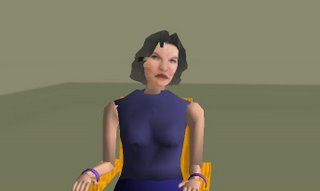As If
[Translations: Japanese]
We are heading into a domain where we create things “as if” they are something else, in imitation of them. Then we improve and deepen the fake with layers of more “as if” until it actually become something else. Our creations go from “as if” to “is.”
Our artificial systems, built to imitate natural ones, primarily work in the realm of as if.
• Second Life is a computer generated environment which surrounds a visitor with visual and sensory 3D details so that the visitor feels “as if” they are visiting in an alternative reality.
• The economies in Second Life, or World of Warcraft, or any other virtual world exhibit many (but not all) the traits we find in the real economy so that it appears “as if” it is an actual economy.
• Computer viruses replicated, adapt, infiltrate, and spread in patterns nearly identical to biological viruses, “as if” they were biological themselves.
• Robots are “as if” beings that we engineer to become more and more “is.”
What does it take to move a manufactured system across the “as if” threshold into the realm of “is?” The answer is the long list of skills that will dominate the coming century.
The desire to cross the line is as old as Pinocchio. If a puppet acts “as if” it were a boy, and his creator can make him more and more boylike, at what point does the puppet really become a boy? The underrated Spielberg movie AI asked this question in a tear-jerk way from the point of view of an extremely realistic robot boy – a modern Pinocchio. The movie’s answer to the riddle of “when does ‘as if’ become is?” was: when the boy could earn the love of a mother.
“As if” operates like a simile, which is an explicit type of metaphor. We could say that Second Life is an immersive metaphor. Or that a flight simulator is an interactive metaphor. That Disneyland is a theme park metaphor. That computer viruses, virtual economies, reality tv shows, and warrior bots in games are all high tech metaphors.
Modern life is a fount of as-if technologies. As Jean Baudrillard showed in his book “Simulacra and Simulation“, hyper realistic fake creations flood our lives, and even rise to the apex of culture. Disneyland is nothing but a hyper-real simulation of a theme park as if it were small town. It succeeds so well in this as-if-ness that it has gone from being as-if to is. It is a fake so real, that it is hyper real. It is now something in itself – Disneyland – that other things aspire to fake. There are in fact many fake Disneylands.
I have a friend, Adam Savage, co-host of the Mythbusters, whose hobby is creating models of famous Hollywood props. (He is not alone in this obsession. There is an entire subculture of prop copiers.) Adam spent several years working on his off-hours to make an exact copy of the Maltese Falcon which starred in the movie of the same name. The prop in the movie is a contrived imaginary sculpture that looks nothing like the original gem, but Adam wanted to re-create the prop and not the original. So he spent an insane number of hours tracking down photographs of the prop, scanning them, sculpting, and eventually casting a duplicate of the “original” prop. He was obsessively making an original copy of a fake, because the fake (the movie prop) was itself hyper-real; it was no longer “as if” but something in itself.

The rather loony levels one can descend in faking fakes should not distract us from the real problems of ascertaining what is real and what is metaphor. A real problem in law is, what counts as sex? You would think that in this most physical of all encounters there would be no question of what was real. But is simulated sex real? Is the metaphoric rape of one artificial avatar by another avatar in a virtual world, virtual or real? Is it a real assault, a real crime? This was the famous question posed by a real legal case about an online game. The answer is not at all obvious.

One solution to this ever more common dilemma is offered by Mel Slater, a virtual reality researcher. Slater repeated a classic psychology experiment in Second Life. In imitation of Stanley Milgram’s famous study of obedience, Slater had authority figures order Second Life volunteers to “torture” other avatars with lethal electric shocks. He concludes “Our results show that in spite of the fact that all participants knew for sure that neither the stranger nor the shocks were real, the participants who saw and heard [the victim] tended to respond to the situation at the subjective, behavioral and physiological levels as if it were real. Or in other words, Slater says, “If you respond as if it were real, then it is Presence.” Presence means experientially real.
Simulations for rehearsing architecture spaces, or designing electronic circuits, or previwing demolition explosions and chemical experiments all are built with the metaphor of realistic actions. Pilot simulators, and virtual simulators for training submariners, police, soldiers, surgery, or for operating big machinery – all these work by eliciting real behavior from the metaphor.
Metaphors become real when we act as if they are real – whether or not we intellectually “believe” they are real. This behavioral definition of “real” means that metaphors are tools.
In this way the role and power of metaphor is rising in our culture. Our modern digital world is a metaphoric world. We make things real by first constructing them as a metaphor, an “as if” type. Then we slowly deepen the metaphor, adding more layers of meaning and realism, until metaphor slowly passes whatever invisible barrier lies between the real and fake, and it becomes “is” — it becomes “real.” Pinocchio is at last a real boy, earning the love of his mother.
We have made as-if realities, which someday may be felt as real. We are making as-if communities, as-if democracies, as-if intelligence, as-if life. One by one, we are moving all existing entities into the as-if realm, and then we’ll pump them up till they cross that Pinocchio line and are indistinguishable from real.
Human society as a superorganism is an ancient metaphor. For thousands of years, humans have looked at human society and seen it “as if” it were an organism. At least since Aristotle the king was seen as society’s head, armies as the supercreature’s armor, miners and farmers as the digestive organ, buildings and bridges as the skeleton. Two thousand years of invention and industrialization have only deepened the parallels of this metaphor. Now it is impossible not to see human society as the dominant superorganism on the planet, consuming resources and growing.
Scientific astronomy and photography have recently extended this metaphor even further. When NASA took a self-portrait photograph of the whole earth in space, the “as-if” single organism was expanded to include the entire planet. Tribes and ethnic races bled into one “family of man.” We also learned that the DNA code of all living creatures is widely shared so that all biomes and ecosystems are distantly related to humans. There is but one life in this as-if superorganism. Even the clouds and geological plates are now seen as part of this metaphorical single planetary superorganism, called Gaia. It is far far larger than humans, but certainly including us. In the new metaphor the whole planet and everything living and inert on it behaves “as if” it were a living organism.
Finally, in the past century, the planetary superorganism metaphor evolved to include intelligence. Multiple layers of telephone trunk lines, satellites orbiting non-stop, cell towers spaced across the globe, transoceanic cables weaving the continents, microwave antenna ringing the shores, and the internet’s web wrapping the globe have awaken in many people a new metaphor: the world looks “as if” it has a global brain.
In fact we are beginning to act as-if there was a global brain. We ask Google expecting it to know the answers to all our many questions. We assume a global awareness: if something happens in Mumbai, we are certain we’ll be able to know about it instantly. We expect this brain to be on, 24/7, feeding our awareness, educating and entertaining us. We currently view it as “our” brain, our collective brain, and that is how we act towards it – even though it is a metaphor.
In this Age of Metaphor, love will be the signal of real. One of the ways we will know when a thing has passed from “as-if to is” is when it earns unalloyed love from humans. When a virtual place wins the kind of full-blooded love that a real place on Earth wins. When a toy pet earns the same love as a breathing pet. When a synthetic actor earns the same love as a human movie star, when a virtual economy incites the same passion as the larger economy, when a global superorganism gains the same affection as a hamster.
Then it will no longer be as-if and it will just be.


